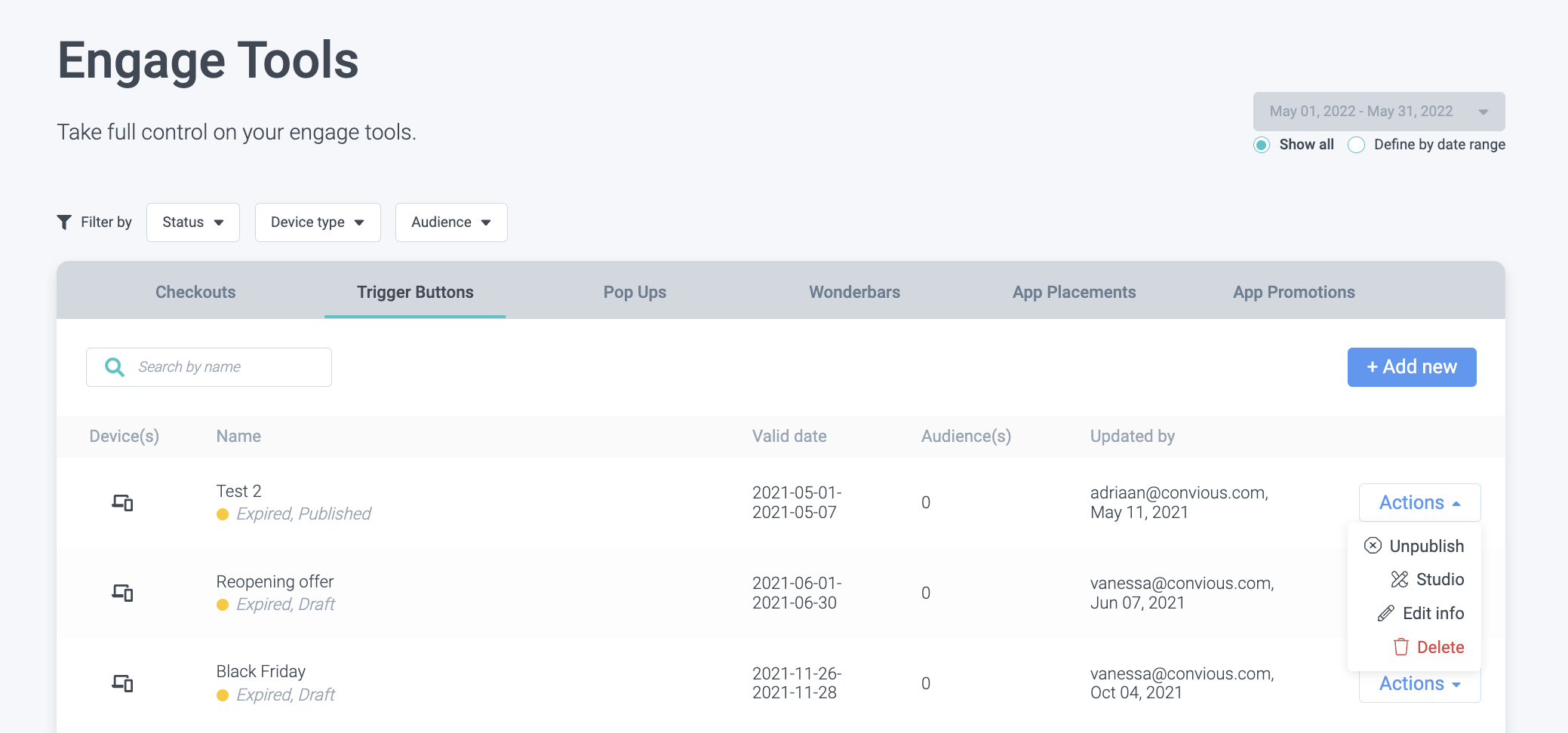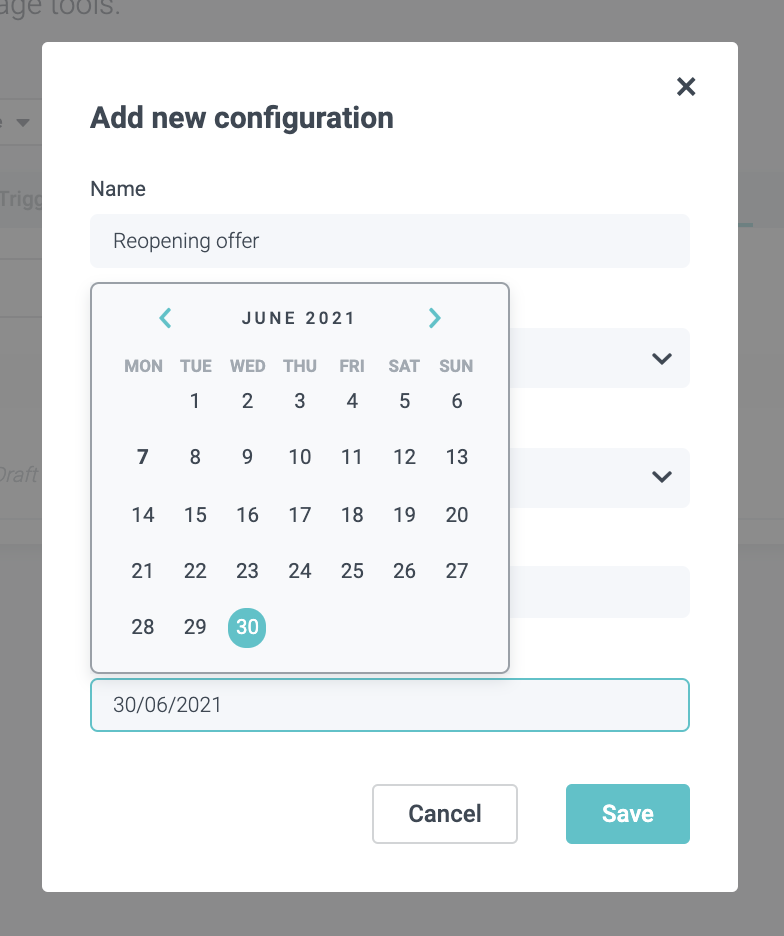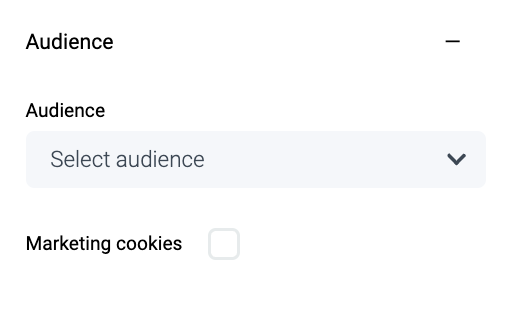As you most likely know, the Trigger Button is a vital part of your Convious platform. It will appear in the bottom-left corner of your website with an engaging and customized text. Once your website visitor clicks, the trigger button opens your Convious ticket shop and allows you to sell more tickets online at better prices.
It is clear that you want your Trigger Button to be as engaging as possible while also integrating perfectly with your website design! Luckily, you will be able to be in charge and this will be the case at all times.
To make sure your engage tools are always in perfect shape for your visitors - you can set up multiple engage tools for different audiences and devices.
Overview
1. How to navigate on your engage tools page
1. Navigate to the main menu on the left-hand side of your screen and click Engage Tools within the Engage section.
Now, you will see all your previously set up engage tools separated by tabs.
To view your setup Trigger Buttons, choose the Trigger Button tab.
In each overview, you can:
- Unpublish or publish an Engage tool version
- Edit its information: Name and device - you can not change its type.
- Studio: edit its text, style, triggering, or settings
- Delete a version
via the Actions option on its right-hand side.
2. Per engage tool, you can filter your previously set-up versions by date range, status, or device type.
2 a) If you want to filter them by date range, you have to choose to Define by date range.
Then you can choose either a custom date range within the calendar or select a pre-defined range.
b) If you want to filter by Status, select Status at the filter menu on the left and select one more status you want to view.
You can filter and view published versions, unpublished versions, drafts, upcoming (scheduled) versions and expired (previously published) versions.
Make sure to select the right status and hit apply.
2 c) Lastly, you can filter by device type. Since you can set up various versions per tool and per device type that they are displayed on, you can now also select to only view mobile versions, desktop versions or those versions that will be displayed on all device types.
Make sure to select the device type you want to filter for and hit apply.
2 d) Lastly, if you are using the power of personalized engage tools and have versions set up by audience type, you can filter by audience.
2. How to create a new Trigger Button
1. Click +Add new, If you don't have it set up yet.
2. Give it a name.
The tool type will be set depending on the engage tool tab you are on.
3. Set up the device you want to trigger this on.
All (default version): This is displayed on desktop as well as mobile and when desktop/mobile versions are not defined.
Desktop: These are desktop or laptop devices with screens larger than 7" in diagonal.
Mobile: These are hand-held devices that include a phone.
4. Schedule your version by setting a start and end date.
5. Click Save.
Do you have questions about scheduling different versions that haven't been answered? Head over to the Convious Engage tools - FAQ.
To edit the Pop up, click on Action and then Studio to enter the Convious Studio.
You will always be able to recognize the Convious Studio by this Logo in the top-left corner:
3. Trigger Button text
The first step within the studio will be setting the language settings, defining text, and linking it.
1. The first step is deciding in which language you will set up your Trigger Button and, subsequently, your Checkout.
We strongly recommend two things:
- Set up your Trigger Button as well as Checkout in the same languages as you have your website, and
- always have both connected to provide a seamless user experience.
There is nothing more disappointing for a native speaker to enter your page, find the Trigger Button in their mother tongue but then not be able to purchase tickets in the same language, although it appeared as such first.
2. Once you have chosen your Language, for example, English and German, you need to decide your default language. This is supposed to be your website's main language.
3. Now, it is time to put in an engaging text! Here you can be creative, but we advise you to be clear to successfully guide your website visitors towards your Checkout.
If you use the Trigger Button for different purposes, which we do not advise you to do, you can also link it to an alternative URL that will function as the destination page your users will be sent to after clicking the button.
5. Next up is creating the translations for the additional languages you chose before.
You enter your text and done!
6. Hit Next to move on the next step of setting up your Trigger Button.
4. Trigger Button style
Now it is time to decide the look and feel of your Trigger Button.
It should be in your interest that your Trigger Button, on the one hand, blends in with your website's design, but at the same time, and this is very important: that it stands out!
If your Trigger Button stands out, your website visitors' attention will be grabbed more easily, and they are more likely to click, leading, subsequently, to more sales!
1. First, you will decide on some general features: Font- Family, Font Color, Font-size, Background color, and Background opacity.
Again, all changes will immediately be visible in your Studio so you can see what it will look like and make great decisions.
2. Next, you will need to choose and design the icon shown within the Trigger Button.
We provide you with a pre-set bundle of a Ticket icon, but you can upload different icons if you want to customize your Trigger Button even further. To do so, you can either browse through your computer files or drag and drop your image.
Choose your
To set color, you can either enter a HEX code, RGB codes or use the cursor to find the color of your choice.
5. Trigger Button targeting
The third step is setting the targeting rules to define which pages your Trigger Button will be shown on.
1. Display on will be pre-set to All Devices as you have chosen to design the Default Version.
2. Secondly, you have the chance to hide your Trigger Button on certain pages in case you would like to do so. If you expand the section with a click, you can choose between URLs that contain, URLs that do not contain, and REGEX.
If you choose URLs that contain, you can add any phrase included in a page URL on which you do not want the Trigger Button to be shown.
If you want, for example, to hide it from your Impressum, you add /impressum to the field and click Add to save.
Then the Trigger Button will not be shown on any URL that contains /impressum
The same works on the contrary if you choose URLS that do not contain.
This might be useful for a multi-location venue. For example, on Amsterdam website page you would like to have a trigger button leading to the Amsterdam product list while on the Paris website page -- Paris product list.
REGEX is short for regular expression, and can be defined as 'a string of text that allows you to create patterns that help match, locate, and manage text.' This is, in most cases, only relevant for developers. We recommend using URLs that contain or URLs that do not contain to make it easy.
Generally, we recommend not to hide your Trigger Button or any of your engagement tools from your pages.
As you can see, we have specified our triggering in extreme detail by adding a series of specific URLs.
3. Hit Next to finalize your Trigger Button.
6. Trigger Button settings
In the last step, you will be able to set further visibility rules that define the Trigger Button's timing to your audience.
1. First, you need to decide on Display
- You have the option to show the Trigger Button Upon Page Load, which is highly recommended as it grabs the website visitors' immediate attention.
- But you can also choose to set it up so that it will show With Delay of your choice.
- Upon the moment, your website visitor tries to exit your site.
- The moment your visitor reaches 50% completion of scrolling through your page.
- Lastly, once your website visitors scroll up your page - require them to first scroll down.
2. Next, you are able to decide on the position of your Trigger Button. All 4 corners of your screen are possible. However, we strongly advise you to keep it on the bottom-left.
When designing our product, we did extensive research on the optimal position, and the bottom-left was a clear winner and was thus, set as the default option.
🎉 Hit Publish to either schedule to go live, go live instantly or select Save draft to come back to editing later!
7. Audiences in Engage tools
If you have the advanced engage tool module included in your contract with us, you can target your website users and create personalized experiences for them. This will not only advance their online purchasing or booking experience but was to be found to have a direct impact on conversion.
So, let's dive into how to set up your engage tool, including audiences.
When entering the targeting section, you should see the following option:
Expand the drop-down to see the entire list of pre-defined audiences you can choose from:
Do you want to give your season pass holders quick access to the reservation flow? Make sure your visitors in the venue today have all the information at hand or find the parking ticket they may have forgotten.
All these are good examples of personalization based on an audience. Let's take the example of your visitors who abandoned their cart.
First, you will need to define the character of the message you have prepared.
Why? Because you can't just use your customers' information for marketing purposes without their consent. But you can target them if the purpose behind your message is merely related to the service you offer.
Service: The communication of new COVID measures or that parking is not possible on parking lot 1 today is considered vital to the service you deliver and, thus, a service message.
Marketing: Targeting your customers to offer parking tickets or upsell a special meal deal is considered marketing.
If your message is a service message, you can disregard the marketing cookie checkbox below the audience selection.
If your message is a marketing message, you need to tick the cookie checkbox below the audience selection because this means that this engage tool version will only be shown to those who consented to have their data used to personalize their experience on your website.
In our example above, we have to tick the marketing cookie checkbox as the message is clearly a marketing message.
Please note that to guarantee you don't miss this important checkbox, we implemented a security pop-up that will remind you to check whether you have set the right filters before you publish. It will only appear if the marketing cookies checkbox is not ticked.
If you're sure to have it all set up right, hit Publish. If you want to revisit it and come back later, hit Save as a draft, and if you want to edit it right away, just hit Cancel, edit your version, and hit publish once again.
Do you not see the audiences in your Convious Studio but want to seize the many possibilities of personalization? Please get in touch with your Customer Success Manager, and we can set it up with you.




























